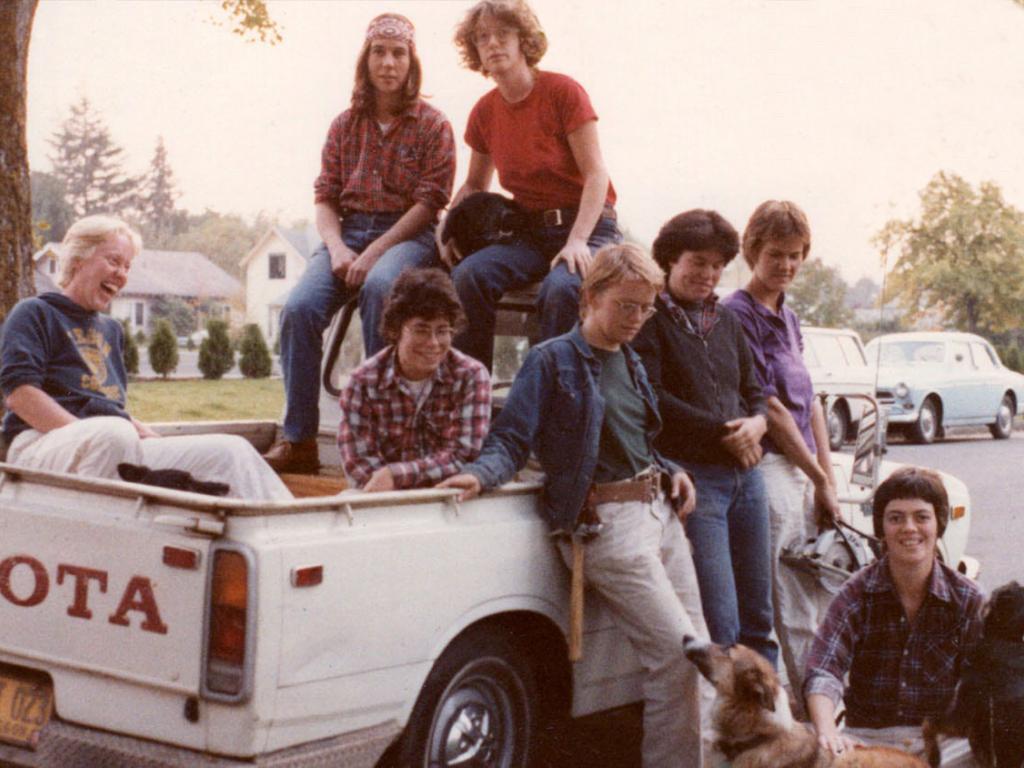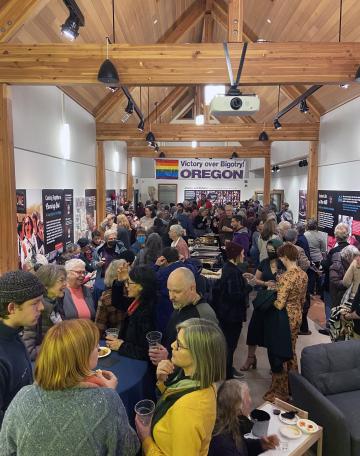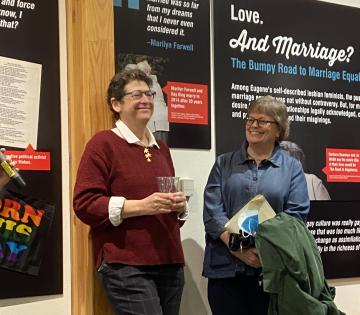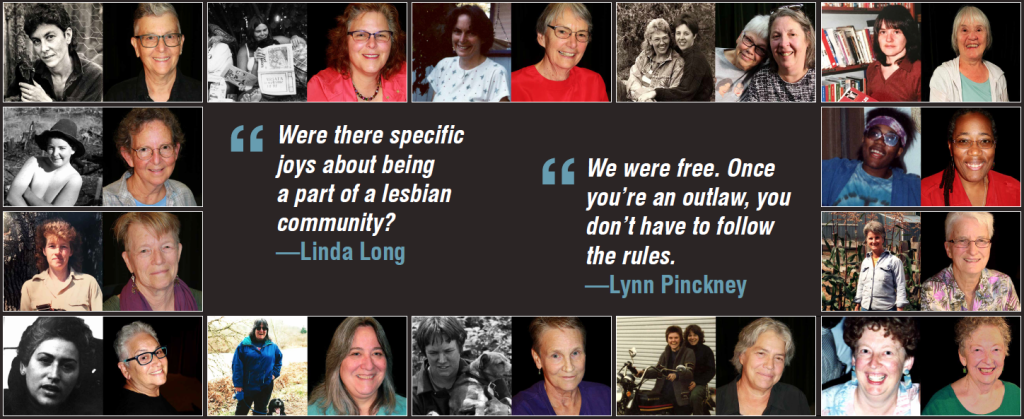
Historians and archivists have mused whether the people living through periods of great social change realized in the moment that they were making history. In the case of the many women who traveled to Eugene during the 1960s-1990s searching for a place that would accept them for who they were and where they could find a supportive community, the answer is yes.
“Outliers and Outlaws: The Eugene Lesbian History Project” is an effort to preserve that history before its participants reach the ends of their lifetimes. The project includes filmed oral histories with 83 narrators, a digital exhibit, an in-person exhibit at the University of Oregon Museum of Natural and Cultural History, and a documentary film.
Envisioned primarily by Linda Long, curator of manuscripts at the University of Oregon Special Collections and University Archives, and Judith Raiskin, an associate professor in women's, gender and sexuality studies, the Outliers and Outlaws project grew from more than just professional curiosity. They lived that history themselves.
“I’ve been waiting my whole career for this kind of collaborative endeavor,” Raiskin said. “Linda had been asking me to do this with her for years, and I too saw it needed to be done because people were passing away. Eugene is a unique city for lesbian history. If you were living in Eugene in the ‘80s, ‘90s, and 2000s, it was all around you.
“This is a generation of queer people who lived ‘out’ in their jobs and in their neighborhoods. They are now in their 70s and 80s. We knew we had to capture the stories of these people.”
A Once-in-a-Lifetime Opportunity
The project began with the Eugene Lesbian Oral History Project to document the history and culture of the longtime Eugene lesbian community. The duo had no trouble finding women in the Eugene lesbian community willing to tell their stories.
“This group of people, they knew their history was important, but there was no way to document it themselves,” she said. “It was amazing how quickly people responded. They were so eager to be able to tell their stories.”

To conduct the oral histories for the Eugene Lesbian Oral History Project, Long and Raiskin interviewed 83 women over two summers. They followed oral history protocols to transcribe, catalogue, and interpret the nearly 200 hours of film, which is also fully searchable by keyword and therefore accessible worldwide. The videos and the transcriptions of the oral history interviews are available via Oregon Digital, the digital depository of the UO Libraries and the OSU Libraries.
Long’s primary focus has been to document lesbian land history in southern Oregon, a celebrated collection visited by researchers from across the world. She is now working on the Eugene Lesbian History Collection, which includes documents donated by many of the narrators from the oral history project.
“To know the impact of this project is enormous – not just for the individuals interviewed, but for other scholars,” Long said. “We created a primary source. That’s the foundation for scholarly investigation.”
From there, Raiskin hired filmmakers Courtney Hermann and Kerribeth Elliott to collaborate with her on a documentary and website that they named “Outliers and Outlaws.”
The digital exhibit is organized into 23 composite videos organized around specific themes, including “Lands,” “Parenting,” “Politics,” and “Aging.” It was important to Raiskin that the collection tell a story and each thematic video had a narrative arc. Raiskin observed that histories of minority and countercultural groups are often pain narratives — stories of the terrible things they experienced — and that she and the film team wanted to show there’s more to these stories than struggle.
“These people lived joyous lives,” she said. “Their lives were full of doing what they wanted to do.”
The professor and the archivist also see the project as a way to help cross generational lines and offer a helping hand to LGBTQ+ youth. One of the themed videos is simply called “Advice,” in which young people are urged to be authentically and fearlessly themselves.
“Most gay and lesbian young people don’t have gay and lesbian parents and grandparents,” Raiskin said. “They don’t see how they’ll live the milestones of their lives through their own family. So often these youth are limited to talking to people their own age. I am very aware of generational differences, and I have been teaching 18- to 23-year-olds a long time. I see the changes ideologically and culturally. The heart of this project is the intergenerational connection.”
Translating a Digital Experience
Building on the overwhelmingly positive participation Long and Raiskin experienced at a talk they gave in 2019 at a local brewery, one facet of the project was to create an in-person exhibit in partnership with the Museum of Natural and Cultural History. They worked with Lauren Willis, curator of academic programs and organizer of the pub talk, and Elizabeth White, the museum's exhibitions designer, to create the in-person exhibit, which is on display through 2023.

“I see my role here as making the museum’s collections or programming or exhibits relevant to people’s lives,” Willis said. “I help answer the question, ‘Why do we keep this history?’”
Willis said at first, she thought translating the digital exhibit would be easy because of the wealth of material Long and Raiskin curated.
“But it wasn’t easy at all. It’s hearing people speak for themselves that is so meaningful, that makes connections. Our challenge was finding ways for people to connect to these stories in a physical space,” Willis said.
Through large-format photos and archival photos, quotes from video narrators, pages from journals, handwritten roommate advertisements, lyric books, and a corner that mimics a bookstore corner down to shelves filled with relevant books for all ages and a place for people to lounge, Willis sought to capture the sparkle of the era and make it an immersive experience by bringing history to life. Willis has also organized well-attended monthly panels and coffee chats with the goal of bringing the public to the exhibit for connection and conversation.
Lexie Briggs, the museum’s marketing and communications specialist, came up with the idea to bring two TikTok influencers to the exhibit’s opening weekend to do a meet-up in the exhibit space. Willis noted that people from around the region who saw the videos on the social media app have visited the exhibit.
“I felt it was important to bring people who represent a broader and more ‘of the now’ queer culture — to really trace the through-line from that era to this one. We wanted to say explicitly that non-binary people are welcome and that queer people who don’t identify as lesbians are welcome in the exhibit,” Briggs said.
Continuing to Make History
Raiskin and Long said that Outliers and Outlaws has also influenced future work, both academically and in the community. One application of the materials is as educational material for elder care facility staff.
“This generation of people is going into long-term care, and many feel they need to be closeted because they’re cognitively and physically vulnerable,” Raiskin said. “I’m hoping this history can be used to educate staff and help explain the meaningful and brave lives of this generation of LGBTQ people. Because of discrimination and lack of equal rights, many of these lesbians have less support, money, and resources to count on, and they need compassionate and knowledgeable care.”
In addition to the videos, Raiskin created the digital exhibit as a teaching tool that includes modules for classroom use, which includes spotlights for teaching, contextual history, tutorials for research, an interactive map of lesbian Eugene, and galleries of photos and documents.
The exhibit has also generated new research directions. Annelise Heinz, associate professor of history, is embarking on a scholarly work using the primary sources of the Outliers and Outlaws project about the ideas of home (found and created), feminism, identity, and historical erasure.
“Linda has almost single handedly made UO special collections one of the most significant centers for lesbian archival history in the world. We have researchers coming from all over the world for those collections,” Heinz said. “When I moved here, I had no idea that Eugene was a significant place for that history. It is under-recognized for those who didn’t live it, even though it’s so recent, which is part of the historical erasure women face and especially lesbian women.”

Heinz is working on a national history of lesbian and feminist intentional communities from the 1970s to the mainstreaming of the internet in the early 2000s. Part of that story are rural communes, feminist bookstores and publications, and women’s credit unions, co-ops, and collectives.
“These communities are hyper-visible in contemporary progressive politics, often as sites of controversy,” Heinz said. “Conflict was always a key part of how these communities worked, which is essential to the larger political process. The existence of conflict — ideological, personal, relational — was not a weakness but a strength. A key element of feminist collectives was consensus decision making. These women were trying to radically reimagine the fundamentals of society.”
Heinz said that in many ways the history the Outliers and Outlaws seeks to uncover has been rendered invisible by societal narratives, the way that history is taught, and whose stories are prioritized. She argues that many of the seismic changes in mid- to late-20th century U.S. political history rests on women’s history.
“These women were re-envisioning identity and rejecting the limitations that were enforced by society of what it is to be a woman,” she said. “There is so much we take for granted today about the changes wrought by feminism that people forget how limited options were.”
Heinz points to many restrictions that were once placed on women, such as not being able to hold a bank account without a male relative sharing the account, lack of legal representation, and the limited types of jobs that were available.
“So many conversations happening today can draw from the insights and pitfalls of these histories. We write them off to our own detriment,” she said.
The patterns hidden in history — history in which Eugene communities played an enormous role — result in transformational movements. By recording stories and connecting narratives, the Outliers and Outlaws project, and the many people who contributed to it, add rich threads to the ongoing tapestry of human history.
Editor’s note: Long and Raiskin would like to recognize the following people and institutions for their contributions to the project: David de Lorenzo, Adriene Lim, Kate Petcosky-Kulkarni, Mackenzie Karp, the UO’s Oregon Humanities Center, staff in UO Libraries Digital Scholarship Services, the Oregon Cultural Trust, UO Libraries, the Williams Family Foundation, the Office of the Vice President for Research and Innovation, the Oregon Heritage State Historic Preservation Office, and Oregon State Parks.
